Bee Pollination Management Assignment 2022
VerifiedAdded on 2022/10/03
|15
|3945
|18
Assignment
AI Summary
Contribute Materials
Your contribution can guide someone’s learning journey. Share your
documents today.

Bee Pollination Management 1
POLLINATION MNAGEMENT IN HORTICULTURE
First Name Last Name
Course
Professor’s Name
University
Date
POLLINATION MNAGEMENT IN HORTICULTURE
First Name Last Name
Course
Professor’s Name
University
Date
Secure Best Marks with AI Grader
Need help grading? Try our AI Grader for instant feedback on your assignments.
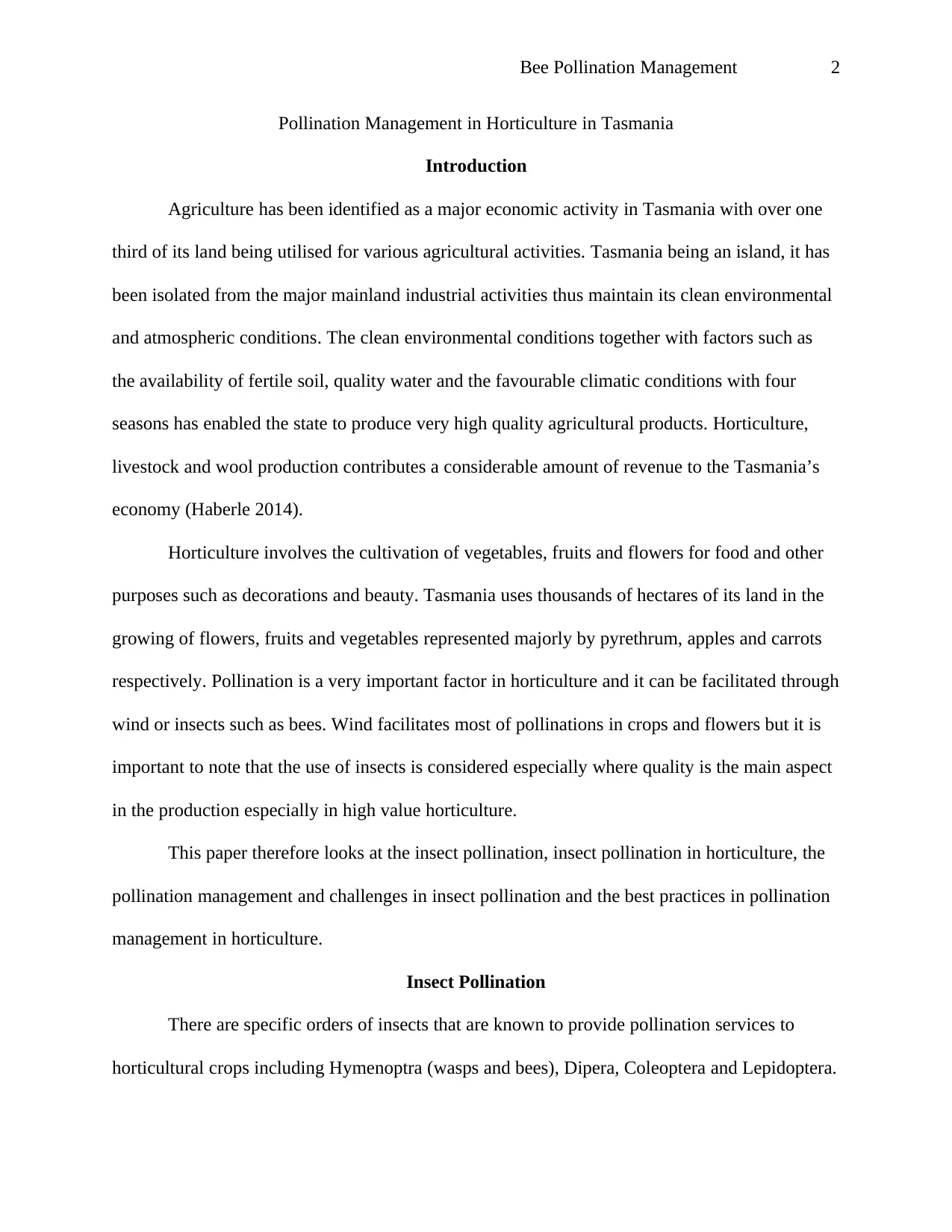
Bee Pollination Management 2
Pollination Management in Horticulture in Tasmania
Introduction
Agriculture has been identified as a major economic activity in Tasmania with over one
third of its land being utilised for various agricultural activities. Tasmania being an island, it has
been isolated from the major mainland industrial activities thus maintain its clean environmental
and atmospheric conditions. The clean environmental conditions together with factors such as
the availability of fertile soil, quality water and the favourable climatic conditions with four
seasons has enabled the state to produce very high quality agricultural products. Horticulture,
livestock and wool production contributes a considerable amount of revenue to the Tasmania’s
economy (Haberle 2014).
Horticulture involves the cultivation of vegetables, fruits and flowers for food and other
purposes such as decorations and beauty. Tasmania uses thousands of hectares of its land in the
growing of flowers, fruits and vegetables represented majorly by pyrethrum, apples and carrots
respectively. Pollination is a very important factor in horticulture and it can be facilitated through
wind or insects such as bees. Wind facilitates most of pollinations in crops and flowers but it is
important to note that the use of insects is considered especially where quality is the main aspect
in the production especially in high value horticulture.
This paper therefore looks at the insect pollination, insect pollination in horticulture, the
pollination management and challenges in insect pollination and the best practices in pollination
management in horticulture.
Insect Pollination
There are specific orders of insects that are known to provide pollination services to
horticultural crops including Hymenoptra (wasps and bees), Dipera, Coleoptera and Lepidoptera.
Pollination Management in Horticulture in Tasmania
Introduction
Agriculture has been identified as a major economic activity in Tasmania with over one
third of its land being utilised for various agricultural activities. Tasmania being an island, it has
been isolated from the major mainland industrial activities thus maintain its clean environmental
and atmospheric conditions. The clean environmental conditions together with factors such as
the availability of fertile soil, quality water and the favourable climatic conditions with four
seasons has enabled the state to produce very high quality agricultural products. Horticulture,
livestock and wool production contributes a considerable amount of revenue to the Tasmania’s
economy (Haberle 2014).
Horticulture involves the cultivation of vegetables, fruits and flowers for food and other
purposes such as decorations and beauty. Tasmania uses thousands of hectares of its land in the
growing of flowers, fruits and vegetables represented majorly by pyrethrum, apples and carrots
respectively. Pollination is a very important factor in horticulture and it can be facilitated through
wind or insects such as bees. Wind facilitates most of pollinations in crops and flowers but it is
important to note that the use of insects is considered especially where quality is the main aspect
in the production especially in high value horticulture.
This paper therefore looks at the insect pollination, insect pollination in horticulture, the
pollination management and challenges in insect pollination and the best practices in pollination
management in horticulture.
Insect Pollination
There are specific orders of insects that are known to provide pollination services to
horticultural crops including Hymenoptra (wasps and bees), Dipera, Coleoptera and Lepidoptera.
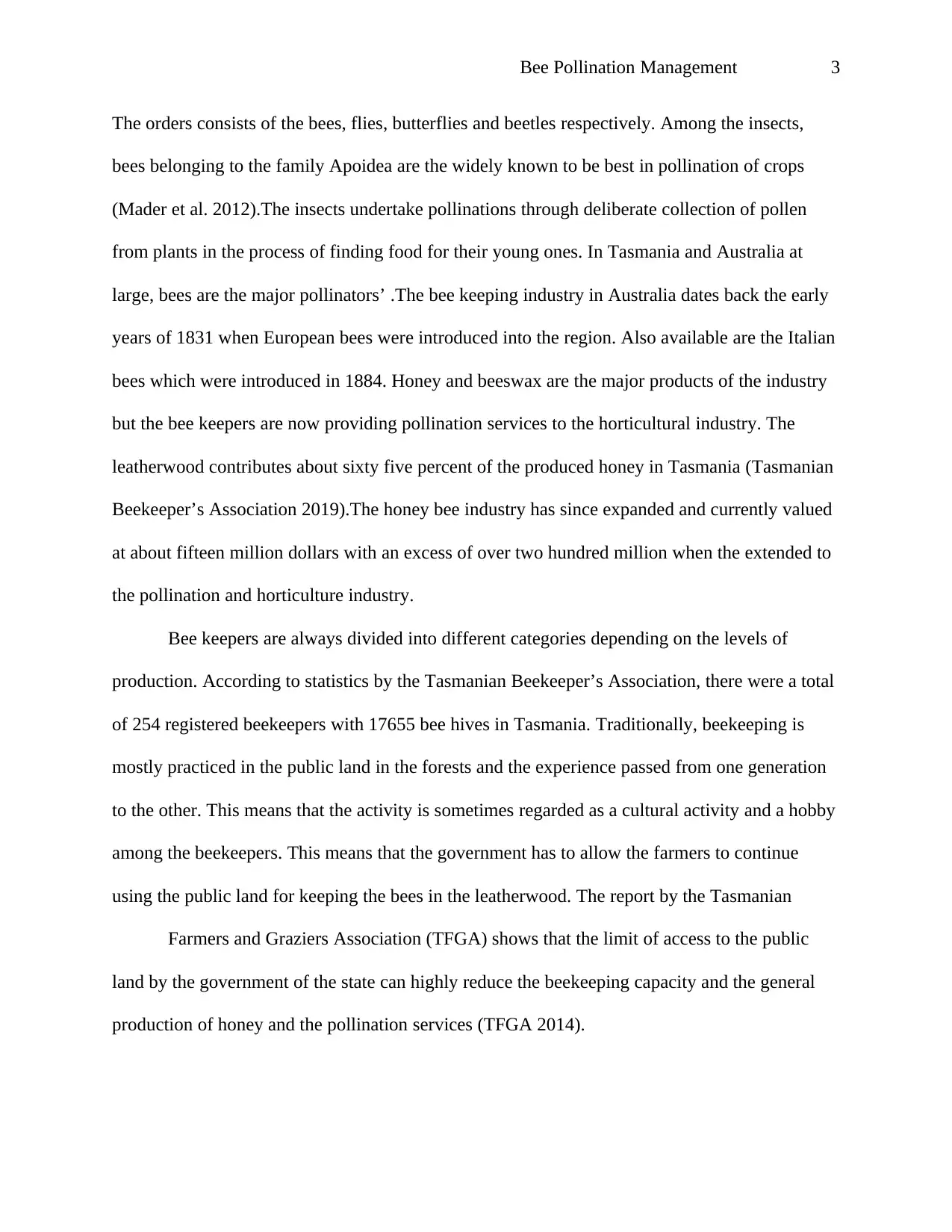
Bee Pollination Management 3
The orders consists of the bees, flies, butterflies and beetles respectively. Among the insects,
bees belonging to the family Apoidea are the widely known to be best in pollination of crops
(Mader et al. 2012).The insects undertake pollinations through deliberate collection of pollen
from plants in the process of finding food for their young ones. In Tasmania and Australia at
large, bees are the major pollinators’ .The bee keeping industry in Australia dates back the early
years of 1831 when European bees were introduced into the region. Also available are the Italian
bees which were introduced in 1884. Honey and beeswax are the major products of the industry
but the bee keepers are now providing pollination services to the horticultural industry. The
leatherwood contributes about sixty five percent of the produced honey in Tasmania (Tasmanian
Beekeeper’s Association 2019).The honey bee industry has since expanded and currently valued
at about fifteen million dollars with an excess of over two hundred million when the extended to
the pollination and horticulture industry.
Bee keepers are always divided into different categories depending on the levels of
production. According to statistics by the Tasmanian Beekeeper’s Association, there were a total
of 254 registered beekeepers with 17655 bee hives in Tasmania. Traditionally, beekeeping is
mostly practiced in the public land in the forests and the experience passed from one generation
to the other. This means that the activity is sometimes regarded as a cultural activity and a hobby
among the beekeepers. This means that the government has to allow the farmers to continue
using the public land for keeping the bees in the leatherwood. The report by the Tasmanian
Farmers and Graziers Association (TFGA) shows that the limit of access to the public
land by the government of the state can highly reduce the beekeeping capacity and the general
production of honey and the pollination services (TFGA 2014).
The orders consists of the bees, flies, butterflies and beetles respectively. Among the insects,
bees belonging to the family Apoidea are the widely known to be best in pollination of crops
(Mader et al. 2012).The insects undertake pollinations through deliberate collection of pollen
from plants in the process of finding food for their young ones. In Tasmania and Australia at
large, bees are the major pollinators’ .The bee keeping industry in Australia dates back the early
years of 1831 when European bees were introduced into the region. Also available are the Italian
bees which were introduced in 1884. Honey and beeswax are the major products of the industry
but the bee keepers are now providing pollination services to the horticultural industry. The
leatherwood contributes about sixty five percent of the produced honey in Tasmania (Tasmanian
Beekeeper’s Association 2019).The honey bee industry has since expanded and currently valued
at about fifteen million dollars with an excess of over two hundred million when the extended to
the pollination and horticulture industry.
Bee keepers are always divided into different categories depending on the levels of
production. According to statistics by the Tasmanian Beekeeper’s Association, there were a total
of 254 registered beekeepers with 17655 bee hives in Tasmania. Traditionally, beekeeping is
mostly practiced in the public land in the forests and the experience passed from one generation
to the other. This means that the activity is sometimes regarded as a cultural activity and a hobby
among the beekeepers. This means that the government has to allow the farmers to continue
using the public land for keeping the bees in the leatherwood. The report by the Tasmanian
Farmers and Graziers Association (TFGA) shows that the limit of access to the public
land by the government of the state can highly reduce the beekeeping capacity and the general
production of honey and the pollination services (TFGA 2014).
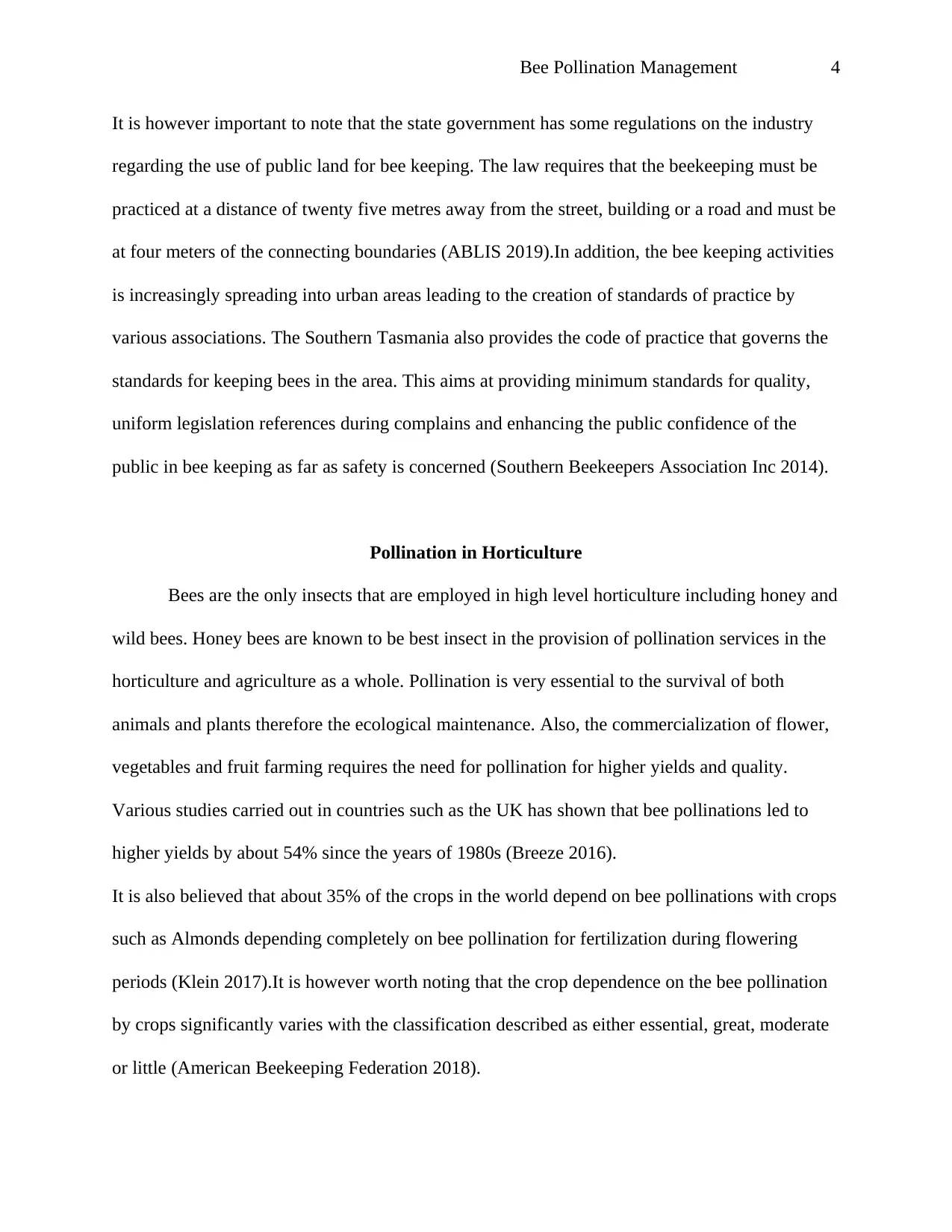
Bee Pollination Management 4
It is however important to note that the state government has some regulations on the industry
regarding the use of public land for bee keeping. The law requires that the beekeeping must be
practiced at a distance of twenty five metres away from the street, building or a road and must be
at four meters of the connecting boundaries (ABLIS 2019).In addition, the bee keeping activities
is increasingly spreading into urban areas leading to the creation of standards of practice by
various associations. The Southern Tasmania also provides the code of practice that governs the
standards for keeping bees in the area. This aims at providing minimum standards for quality,
uniform legislation references during complains and enhancing the public confidence of the
public in bee keeping as far as safety is concerned (Southern Beekeepers Association Inc 2014).
Pollination in Horticulture
Bees are the only insects that are employed in high level horticulture including honey and
wild bees. Honey bees are known to be best insect in the provision of pollination services in the
horticulture and agriculture as a whole. Pollination is very essential to the survival of both
animals and plants therefore the ecological maintenance. Also, the commercialization of flower,
vegetables and fruit farming requires the need for pollination for higher yields and quality.
Various studies carried out in countries such as the UK has shown that bee pollinations led to
higher yields by about 54% since the years of 1980s (Breeze 2016).
It is also believed that about 35% of the crops in the world depend on bee pollinations with crops
such as Almonds depending completely on bee pollination for fertilization during flowering
periods (Klein 2017).It is however worth noting that the crop dependence on the bee pollination
by crops significantly varies with the classification described as either essential, great, moderate
or little (American Beekeeping Federation 2018).
It is however important to note that the state government has some regulations on the industry
regarding the use of public land for bee keeping. The law requires that the beekeeping must be
practiced at a distance of twenty five metres away from the street, building or a road and must be
at four meters of the connecting boundaries (ABLIS 2019).In addition, the bee keeping activities
is increasingly spreading into urban areas leading to the creation of standards of practice by
various associations. The Southern Tasmania also provides the code of practice that governs the
standards for keeping bees in the area. This aims at providing minimum standards for quality,
uniform legislation references during complains and enhancing the public confidence of the
public in bee keeping as far as safety is concerned (Southern Beekeepers Association Inc 2014).
Pollination in Horticulture
Bees are the only insects that are employed in high level horticulture including honey and
wild bees. Honey bees are known to be best insect in the provision of pollination services in the
horticulture and agriculture as a whole. Pollination is very essential to the survival of both
animals and plants therefore the ecological maintenance. Also, the commercialization of flower,
vegetables and fruit farming requires the need for pollination for higher yields and quality.
Various studies carried out in countries such as the UK has shown that bee pollinations led to
higher yields by about 54% since the years of 1980s (Breeze 2016).
It is also believed that about 35% of the crops in the world depend on bee pollinations with crops
such as Almonds depending completely on bee pollination for fertilization during flowering
periods (Klein 2017).It is however worth noting that the crop dependence on the bee pollination
by crops significantly varies with the classification described as either essential, great, moderate
or little (American Beekeeping Federation 2018).
Secure Best Marks with AI Grader
Need help grading? Try our AI Grader for instant feedback on your assignments.
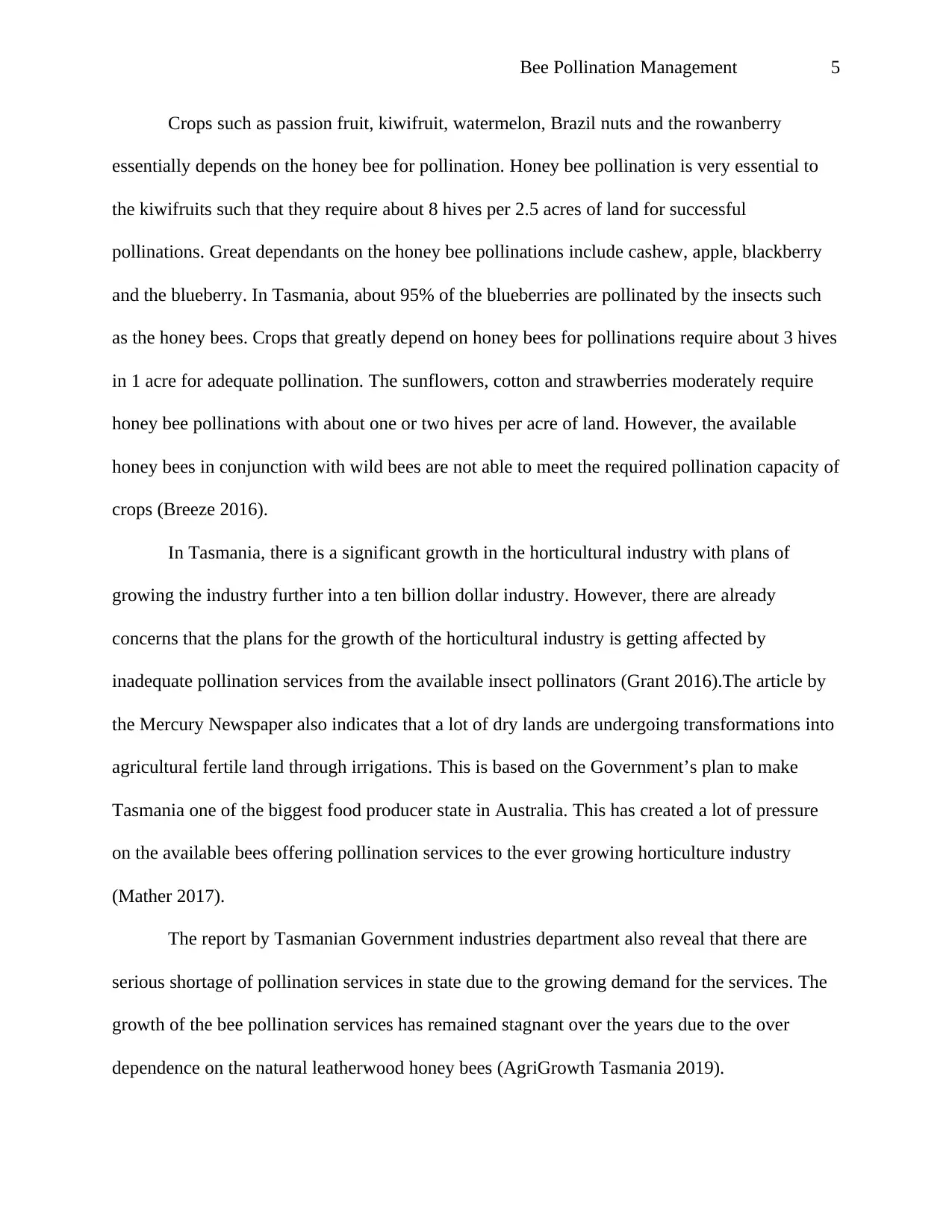
Bee Pollination Management 5
Crops such as passion fruit, kiwifruit, watermelon, Brazil nuts and the rowanberry
essentially depends on the honey bee for pollination. Honey bee pollination is very essential to
the kiwifruits such that they require about 8 hives per 2.5 acres of land for successful
pollinations. Great dependants on the honey bee pollinations include cashew, apple, blackberry
and the blueberry. In Tasmania, about 95% of the blueberries are pollinated by the insects such
as the honey bees. Crops that greatly depend on honey bees for pollinations require about 3 hives
in 1 acre for adequate pollination. The sunflowers, cotton and strawberries moderately require
honey bee pollinations with about one or two hives per acre of land. However, the available
honey bees in conjunction with wild bees are not able to meet the required pollination capacity of
crops (Breeze 2016).
In Tasmania, there is a significant growth in the horticultural industry with plans of
growing the industry further into a ten billion dollar industry. However, there are already
concerns that the plans for the growth of the horticultural industry is getting affected by
inadequate pollination services from the available insect pollinators (Grant 2016).The article by
the Mercury Newspaper also indicates that a lot of dry lands are undergoing transformations into
agricultural fertile land through irrigations. This is based on the Government’s plan to make
Tasmania one of the biggest food producer state in Australia. This has created a lot of pressure
on the available bees offering pollination services to the ever growing horticulture industry
(Mather 2017).
The report by Tasmanian Government industries department also reveal that there are
serious shortage of pollination services in state due to the growing demand for the services. The
growth of the bee pollination services has remained stagnant over the years due to the over
dependence on the natural leatherwood honey bees (AgriGrowth Tasmania 2019).
Crops such as passion fruit, kiwifruit, watermelon, Brazil nuts and the rowanberry
essentially depends on the honey bee for pollination. Honey bee pollination is very essential to
the kiwifruits such that they require about 8 hives per 2.5 acres of land for successful
pollinations. Great dependants on the honey bee pollinations include cashew, apple, blackberry
and the blueberry. In Tasmania, about 95% of the blueberries are pollinated by the insects such
as the honey bees. Crops that greatly depend on honey bees for pollinations require about 3 hives
in 1 acre for adequate pollination. The sunflowers, cotton and strawberries moderately require
honey bee pollinations with about one or two hives per acre of land. However, the available
honey bees in conjunction with wild bees are not able to meet the required pollination capacity of
crops (Breeze 2016).
In Tasmania, there is a significant growth in the horticultural industry with plans of
growing the industry further into a ten billion dollar industry. However, there are already
concerns that the plans for the growth of the horticultural industry is getting affected by
inadequate pollination services from the available insect pollinators (Grant 2016).The article by
the Mercury Newspaper also indicates that a lot of dry lands are undergoing transformations into
agricultural fertile land through irrigations. This is based on the Government’s plan to make
Tasmania one of the biggest food producer state in Australia. This has created a lot of pressure
on the available bees offering pollination services to the ever growing horticulture industry
(Mather 2017).
The report by Tasmanian Government industries department also reveal that there are
serious shortage of pollination services in state due to the growing demand for the services. The
growth of the bee pollination services has remained stagnant over the years due to the over
dependence on the natural leatherwood honey bees (AgriGrowth Tasmania 2019).
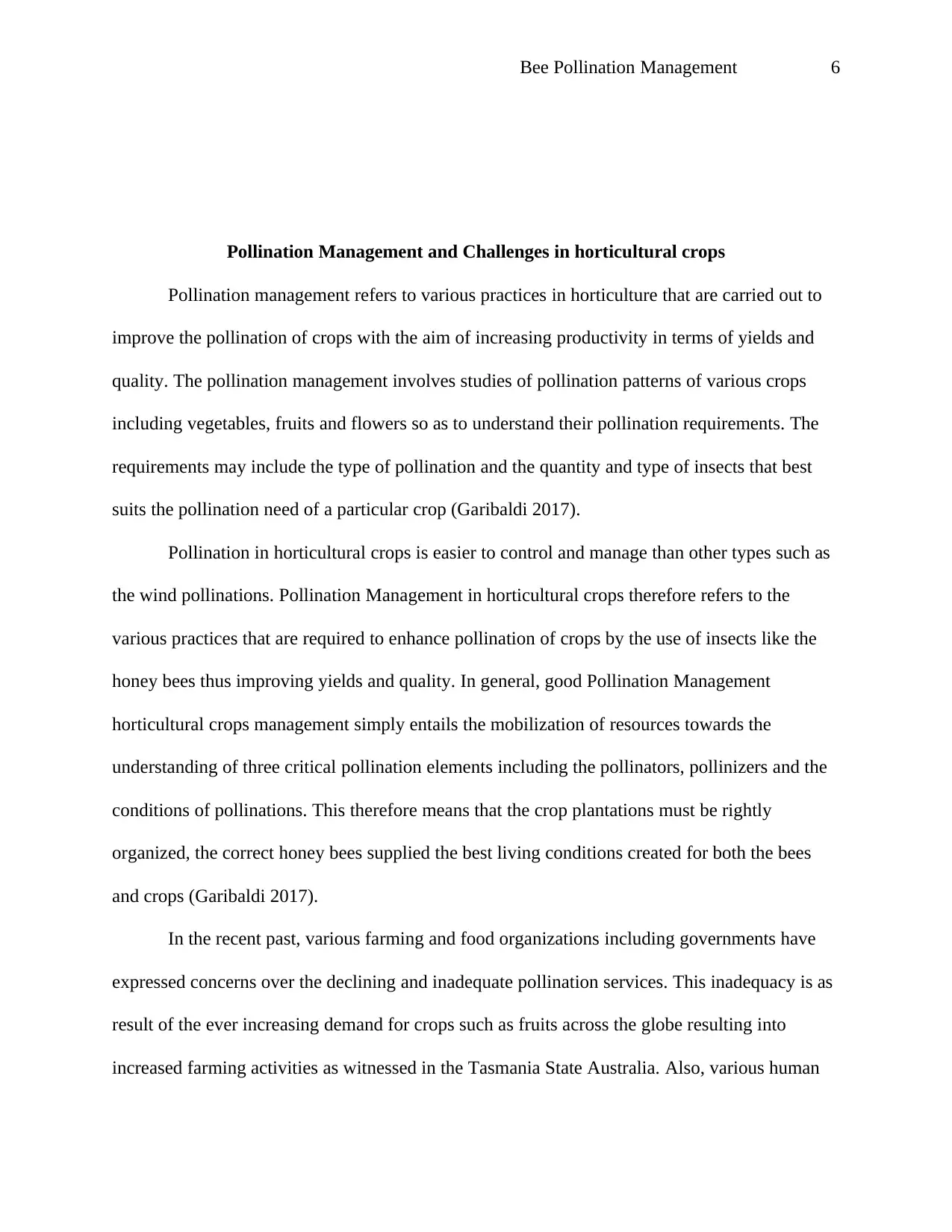
Bee Pollination Management 6
Pollination Management and Challenges in horticultural crops
Pollination management refers to various practices in horticulture that are carried out to
improve the pollination of crops with the aim of increasing productivity in terms of yields and
quality. The pollination management involves studies of pollination patterns of various crops
including vegetables, fruits and flowers so as to understand their pollination requirements. The
requirements may include the type of pollination and the quantity and type of insects that best
suits the pollination need of a particular crop (Garibaldi 2017).
Pollination in horticultural crops is easier to control and manage than other types such as
the wind pollinations. Pollination Management in horticultural crops therefore refers to the
various practices that are required to enhance pollination of crops by the use of insects like the
honey bees thus improving yields and quality. In general, good Pollination Management
horticultural crops management simply entails the mobilization of resources towards the
understanding of three critical pollination elements including the pollinators, pollinizers and the
conditions of pollinations. This therefore means that the crop plantations must be rightly
organized, the correct honey bees supplied the best living conditions created for both the bees
and crops (Garibaldi 2017).
In the recent past, various farming and food organizations including governments have
expressed concerns over the declining and inadequate pollination services. This inadequacy is as
result of the ever increasing demand for crops such as fruits across the globe resulting into
increased farming activities as witnessed in the Tasmania State Australia. Also, various human
Pollination Management and Challenges in horticultural crops
Pollination management refers to various practices in horticulture that are carried out to
improve the pollination of crops with the aim of increasing productivity in terms of yields and
quality. The pollination management involves studies of pollination patterns of various crops
including vegetables, fruits and flowers so as to understand their pollination requirements. The
requirements may include the type of pollination and the quantity and type of insects that best
suits the pollination need of a particular crop (Garibaldi 2017).
Pollination in horticultural crops is easier to control and manage than other types such as
the wind pollinations. Pollination Management in horticultural crops therefore refers to the
various practices that are required to enhance pollination of crops by the use of insects like the
honey bees thus improving yields and quality. In general, good Pollination Management
horticultural crops management simply entails the mobilization of resources towards the
understanding of three critical pollination elements including the pollinators, pollinizers and the
conditions of pollinations. This therefore means that the crop plantations must be rightly
organized, the correct honey bees supplied the best living conditions created for both the bees
and crops (Garibaldi 2017).
In the recent past, various farming and food organizations including governments have
expressed concerns over the declining and inadequate pollination services. This inadequacy is as
result of the ever increasing demand for crops such as fruits across the globe resulting into
increased farming activities as witnessed in the Tasmania State Australia. Also, various human
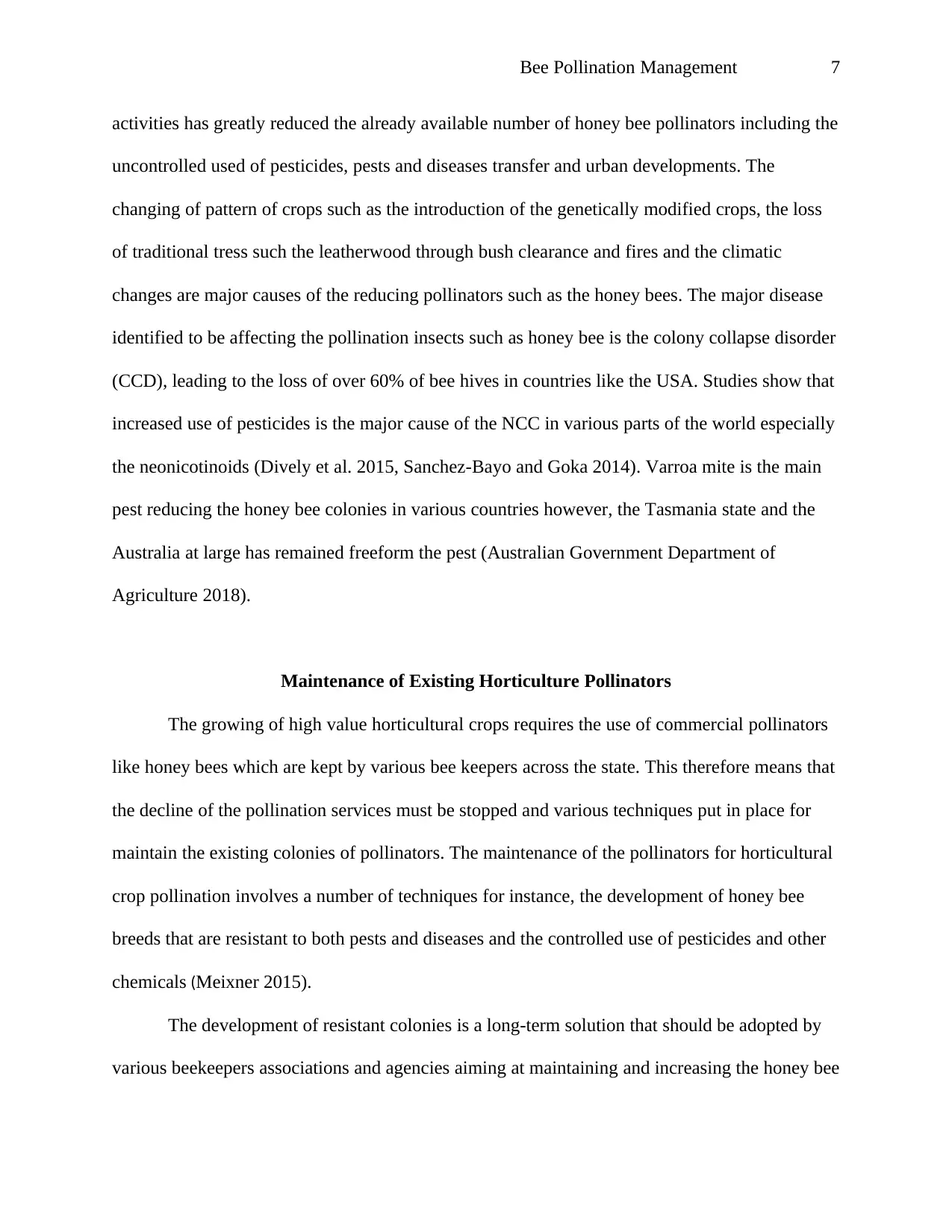
Bee Pollination Management 7
activities has greatly reduced the already available number of honey bee pollinators including the
uncontrolled used of pesticides, pests and diseases transfer and urban developments. The
changing of pattern of crops such as the introduction of the genetically modified crops, the loss
of traditional tress such the leatherwood through bush clearance and fires and the climatic
changes are major causes of the reducing pollinators such as the honey bees. The major disease
identified to be affecting the pollination insects such as honey bee is the colony collapse disorder
(CCD), leading to the loss of over 60% of bee hives in countries like the USA. Studies show that
increased use of pesticides is the major cause of the NCC in various parts of the world especially
the neonicotinoids (Dively et al. 2015, Sanchez-Bayo and Goka 2014). Varroa mite is the main
pest reducing the honey bee colonies in various countries however, the Tasmania state and the
Australia at large has remained freeform the pest (Australian Government Department of
Agriculture 2018).
Maintenance of Existing Horticulture Pollinators
The growing of high value horticultural crops requires the use of commercial pollinators
like honey bees which are kept by various bee keepers across the state. This therefore means that
the decline of the pollination services must be stopped and various techniques put in place for
maintain the existing colonies of pollinators. The maintenance of the pollinators for horticultural
crop pollination involves a number of techniques for instance, the development of honey bee
breeds that are resistant to both pests and diseases and the controlled use of pesticides and other
chemicals (Meixner 2015).
The development of resistant colonies is a long-term solution that should be adopted by
various beekeepers associations and agencies aiming at maintaining and increasing the honey bee
activities has greatly reduced the already available number of honey bee pollinators including the
uncontrolled used of pesticides, pests and diseases transfer and urban developments. The
changing of pattern of crops such as the introduction of the genetically modified crops, the loss
of traditional tress such the leatherwood through bush clearance and fires and the climatic
changes are major causes of the reducing pollinators such as the honey bees. The major disease
identified to be affecting the pollination insects such as honey bee is the colony collapse disorder
(CCD), leading to the loss of over 60% of bee hives in countries like the USA. Studies show that
increased use of pesticides is the major cause of the NCC in various parts of the world especially
the neonicotinoids (Dively et al. 2015, Sanchez-Bayo and Goka 2014). Varroa mite is the main
pest reducing the honey bee colonies in various countries however, the Tasmania state and the
Australia at large has remained freeform the pest (Australian Government Department of
Agriculture 2018).
Maintenance of Existing Horticulture Pollinators
The growing of high value horticultural crops requires the use of commercial pollinators
like honey bees which are kept by various bee keepers across the state. This therefore means that
the decline of the pollination services must be stopped and various techniques put in place for
maintain the existing colonies of pollinators. The maintenance of the pollinators for horticultural
crop pollination involves a number of techniques for instance, the development of honey bee
breeds that are resistant to both pests and diseases and the controlled use of pesticides and other
chemicals (Meixner 2015).
The development of resistant colonies is a long-term solution that should be adopted by
various beekeepers associations and agencies aiming at maintaining and increasing the honey bee
Paraphrase This Document
Need a fresh take? Get an instant paraphrase of this document with our AI Paraphraser
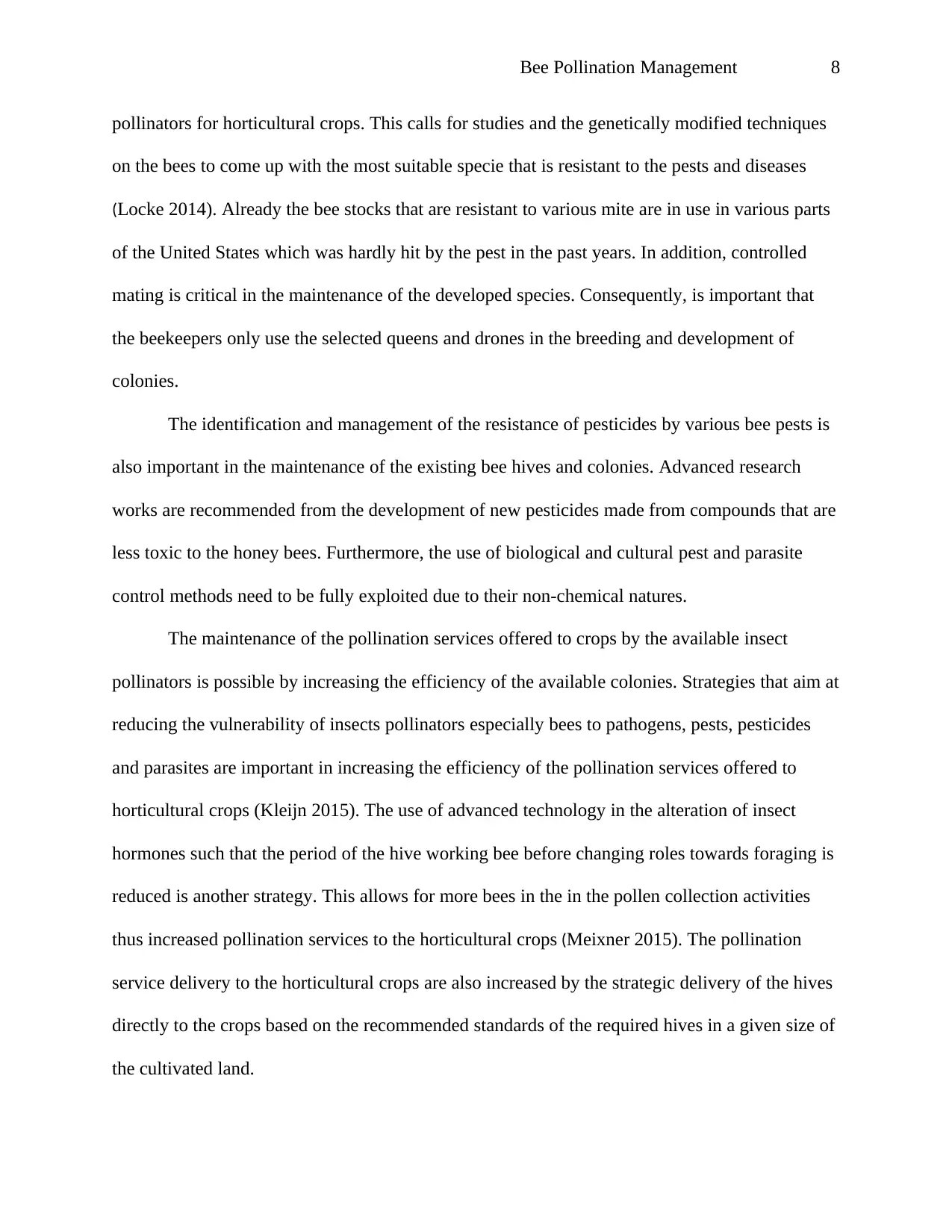
Bee Pollination Management 8
pollinators for horticultural crops. This calls for studies and the genetically modified techniques
on the bees to come up with the most suitable specie that is resistant to the pests and diseases
(Locke 2014). Already the bee stocks that are resistant to various mite are in use in various parts
of the United States which was hardly hit by the pest in the past years. In addition, controlled
mating is critical in the maintenance of the developed species. Consequently, is important that
the beekeepers only use the selected queens and drones in the breeding and development of
colonies.
The identification and management of the resistance of pesticides by various bee pests is
also important in the maintenance of the existing bee hives and colonies. Advanced research
works are recommended from the development of new pesticides made from compounds that are
less toxic to the honey bees. Furthermore, the use of biological and cultural pest and parasite
control methods need to be fully exploited due to their non-chemical natures.
The maintenance of the pollination services offered to crops by the available insect
pollinators is possible by increasing the efficiency of the available colonies. Strategies that aim at
reducing the vulnerability of insects pollinators especially bees to pathogens, pests, pesticides
and parasites are important in increasing the efficiency of the pollination services offered to
horticultural crops (Kleijn 2015). The use of advanced technology in the alteration of insect
hormones such that the period of the hive working bee before changing roles towards foraging is
reduced is another strategy. This allows for more bees in the in the pollen collection activities
thus increased pollination services to the horticultural crops (Meixner 2015). The pollination
service delivery to the horticultural crops are also increased by the strategic delivery of the hives
directly to the crops based on the recommended standards of the required hives in a given size of
the cultivated land.
pollinators for horticultural crops. This calls for studies and the genetically modified techniques
on the bees to come up with the most suitable specie that is resistant to the pests and diseases
(Locke 2014). Already the bee stocks that are resistant to various mite are in use in various parts
of the United States which was hardly hit by the pest in the past years. In addition, controlled
mating is critical in the maintenance of the developed species. Consequently, is important that
the beekeepers only use the selected queens and drones in the breeding and development of
colonies.
The identification and management of the resistance of pesticides by various bee pests is
also important in the maintenance of the existing bee hives and colonies. Advanced research
works are recommended from the development of new pesticides made from compounds that are
less toxic to the honey bees. Furthermore, the use of biological and cultural pest and parasite
control methods need to be fully exploited due to their non-chemical natures.
The maintenance of the pollination services offered to crops by the available insect
pollinators is possible by increasing the efficiency of the available colonies. Strategies that aim at
reducing the vulnerability of insects pollinators especially bees to pathogens, pests, pesticides
and parasites are important in increasing the efficiency of the pollination services offered to
horticultural crops (Kleijn 2015). The use of advanced technology in the alteration of insect
hormones such that the period of the hive working bee before changing roles towards foraging is
reduced is another strategy. This allows for more bees in the in the pollen collection activities
thus increased pollination services to the horticultural crops (Meixner 2015). The pollination
service delivery to the horticultural crops are also increased by the strategic delivery of the hives
directly to the crops based on the recommended standards of the required hives in a given size of
the cultivated land.
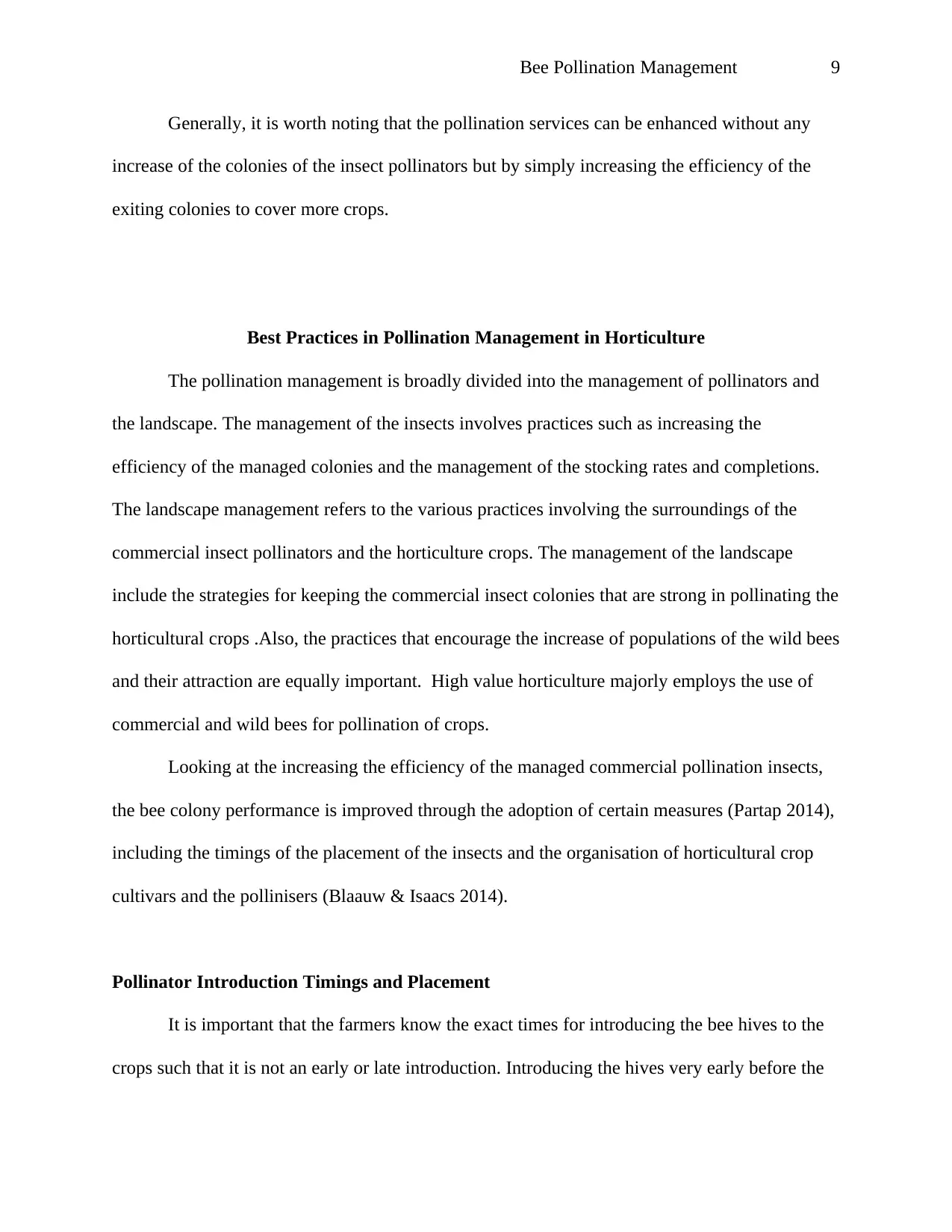
Bee Pollination Management 9
Generally, it is worth noting that the pollination services can be enhanced without any
increase of the colonies of the insect pollinators but by simply increasing the efficiency of the
exiting colonies to cover more crops.
Best Practices in Pollination Management in Horticulture
The pollination management is broadly divided into the management of pollinators and
the landscape. The management of the insects involves practices such as increasing the
efficiency of the managed colonies and the management of the stocking rates and completions.
The landscape management refers to the various practices involving the surroundings of the
commercial insect pollinators and the horticulture crops. The management of the landscape
include the strategies for keeping the commercial insect colonies that are strong in pollinating the
horticultural crops .Also, the practices that encourage the increase of populations of the wild bees
and their attraction are equally important. High value horticulture majorly employs the use of
commercial and wild bees for pollination of crops.
Looking at the increasing the efficiency of the managed commercial pollination insects,
the bee colony performance is improved through the adoption of certain measures (Partap 2014),
including the timings of the placement of the insects and the organisation of horticultural crop
cultivars and the pollinisers (Blaauw & Isaacs 2014).
Pollinator Introduction Timings and Placement
It is important that the farmers know the exact times for introducing the bee hives to the
crops such that it is not an early or late introduction. Introducing the hives very early before the
Generally, it is worth noting that the pollination services can be enhanced without any
increase of the colonies of the insect pollinators but by simply increasing the efficiency of the
exiting colonies to cover more crops.
Best Practices in Pollination Management in Horticulture
The pollination management is broadly divided into the management of pollinators and
the landscape. The management of the insects involves practices such as increasing the
efficiency of the managed colonies and the management of the stocking rates and completions.
The landscape management refers to the various practices involving the surroundings of the
commercial insect pollinators and the horticulture crops. The management of the landscape
include the strategies for keeping the commercial insect colonies that are strong in pollinating the
horticultural crops .Also, the practices that encourage the increase of populations of the wild bees
and their attraction are equally important. High value horticulture majorly employs the use of
commercial and wild bees for pollination of crops.
Looking at the increasing the efficiency of the managed commercial pollination insects,
the bee colony performance is improved through the adoption of certain measures (Partap 2014),
including the timings of the placement of the insects and the organisation of horticultural crop
cultivars and the pollinisers (Blaauw & Isaacs 2014).
Pollinator Introduction Timings and Placement
It is important that the farmers know the exact times for introducing the bee hives to the
crops such that it is not an early or late introduction. Introducing the hives very early before the
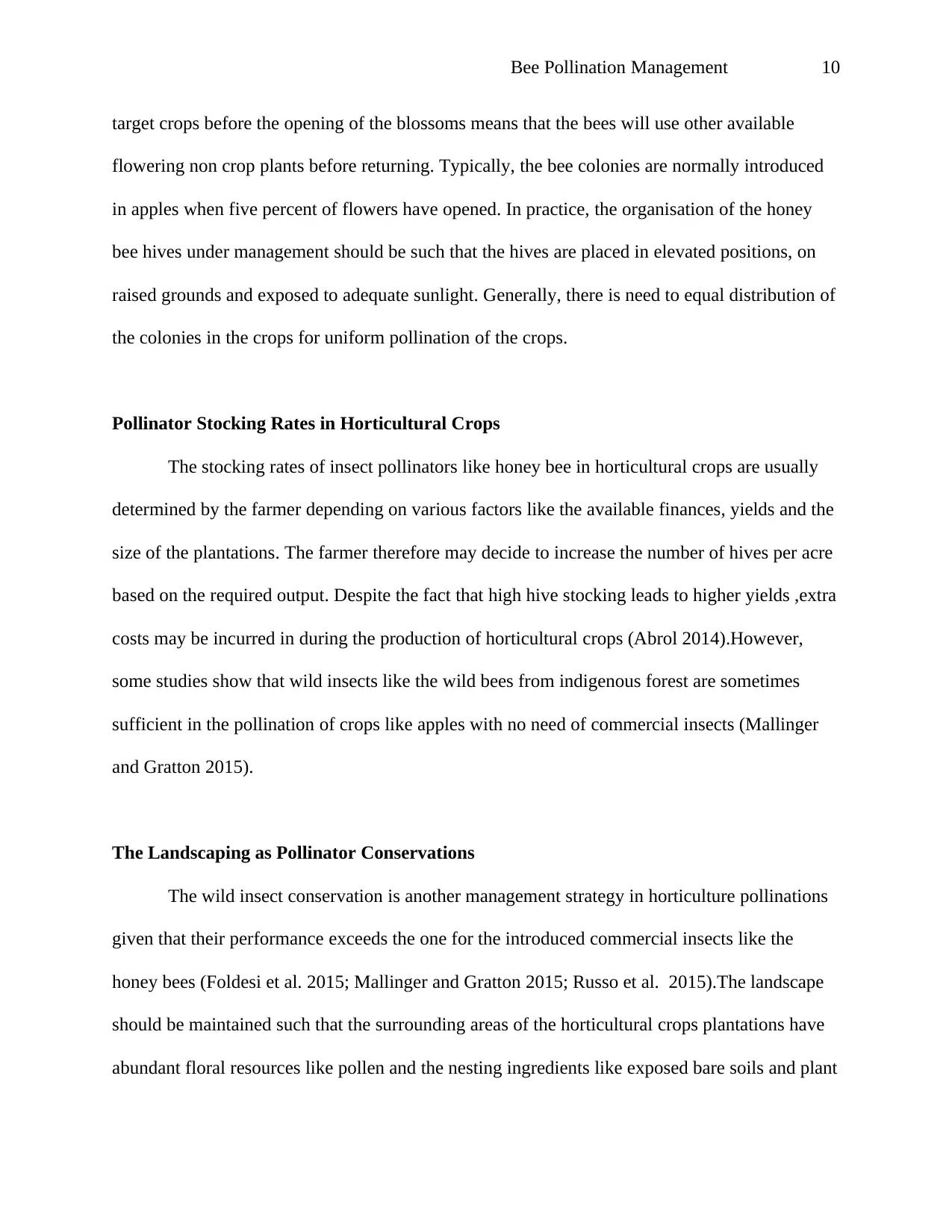
Bee Pollination Management 10
target crops before the opening of the blossoms means that the bees will use other available
flowering non crop plants before returning. Typically, the bee colonies are normally introduced
in apples when five percent of flowers have opened. In practice, the organisation of the honey
bee hives under management should be such that the hives are placed in elevated positions, on
raised grounds and exposed to adequate sunlight. Generally, there is need to equal distribution of
the colonies in the crops for uniform pollination of the crops.
Pollinator Stocking Rates in Horticultural Crops
The stocking rates of insect pollinators like honey bee in horticultural crops are usually
determined by the farmer depending on various factors like the available finances, yields and the
size of the plantations. The farmer therefore may decide to increase the number of hives per acre
based on the required output. Despite the fact that high hive stocking leads to higher yields ,extra
costs may be incurred in during the production of horticultural crops (Abrol 2014).However,
some studies show that wild insects like the wild bees from indigenous forest are sometimes
sufficient in the pollination of crops like apples with no need of commercial insects (Mallinger
and Gratton 2015).
The Landscaping as Pollinator Conservations
The wild insect conservation is another management strategy in horticulture pollinations
given that their performance exceeds the one for the introduced commercial insects like the
honey bees (Foldesi et al. 2015; Mallinger and Gratton 2015; Russo et al. 2015).The landscape
should be maintained such that the surrounding areas of the horticultural crops plantations have
abundant floral resources like pollen and the nesting ingredients like exposed bare soils and plant
target crops before the opening of the blossoms means that the bees will use other available
flowering non crop plants before returning. Typically, the bee colonies are normally introduced
in apples when five percent of flowers have opened. In practice, the organisation of the honey
bee hives under management should be such that the hives are placed in elevated positions, on
raised grounds and exposed to adequate sunlight. Generally, there is need to equal distribution of
the colonies in the crops for uniform pollination of the crops.
Pollinator Stocking Rates in Horticultural Crops
The stocking rates of insect pollinators like honey bee in horticultural crops are usually
determined by the farmer depending on various factors like the available finances, yields and the
size of the plantations. The farmer therefore may decide to increase the number of hives per acre
based on the required output. Despite the fact that high hive stocking leads to higher yields ,extra
costs may be incurred in during the production of horticultural crops (Abrol 2014).However,
some studies show that wild insects like the wild bees from indigenous forest are sometimes
sufficient in the pollination of crops like apples with no need of commercial insects (Mallinger
and Gratton 2015).
The Landscaping as Pollinator Conservations
The wild insect conservation is another management strategy in horticulture pollinations
given that their performance exceeds the one for the introduced commercial insects like the
honey bees (Foldesi et al. 2015; Mallinger and Gratton 2015; Russo et al. 2015).The landscape
should be maintained such that the surrounding areas of the horticultural crops plantations have
abundant floral resources like pollen and the nesting ingredients like exposed bare soils and plant
Secure Best Marks with AI Grader
Need help grading? Try our AI Grader for instant feedback on your assignments.
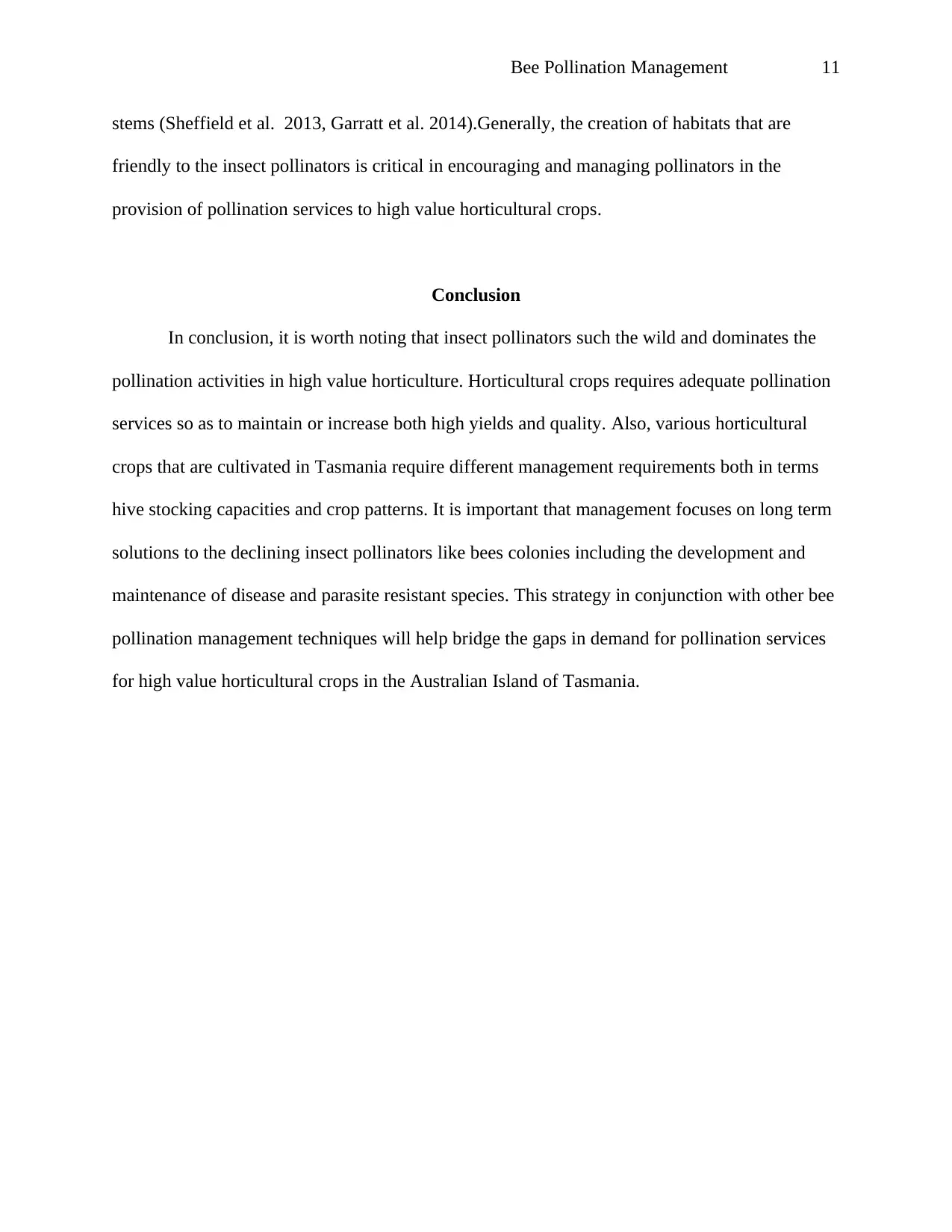
Bee Pollination Management 11
stems (Sheffield et al. 2013, Garratt et al. 2014).Generally, the creation of habitats that are
friendly to the insect pollinators is critical in encouraging and managing pollinators in the
provision of pollination services to high value horticultural crops.
Conclusion
In conclusion, it is worth noting that insect pollinators such the wild and dominates the
pollination activities in high value horticulture. Horticultural crops requires adequate pollination
services so as to maintain or increase both high yields and quality. Also, various horticultural
crops that are cultivated in Tasmania require different management requirements both in terms
hive stocking capacities and crop patterns. It is important that management focuses on long term
solutions to the declining insect pollinators like bees colonies including the development and
maintenance of disease and parasite resistant species. This strategy in conjunction with other bee
pollination management techniques will help bridge the gaps in demand for pollination services
for high value horticultural crops in the Australian Island of Tasmania.
stems (Sheffield et al. 2013, Garratt et al. 2014).Generally, the creation of habitats that are
friendly to the insect pollinators is critical in encouraging and managing pollinators in the
provision of pollination services to high value horticultural crops.
Conclusion
In conclusion, it is worth noting that insect pollinators such the wild and dominates the
pollination activities in high value horticulture. Horticultural crops requires adequate pollination
services so as to maintain or increase both high yields and quality. Also, various horticultural
crops that are cultivated in Tasmania require different management requirements both in terms
hive stocking capacities and crop patterns. It is important that management focuses on long term
solutions to the declining insect pollinators like bees colonies including the development and
maintenance of disease and parasite resistant species. This strategy in conjunction with other bee
pollination management techniques will help bridge the gaps in demand for pollination services
for high value horticultural crops in the Australian Island of Tasmania.

Bee Pollination Management 12
Reference List
ABLIS, 2019. Approval to Keep Bee Hives – Tasmania. Available from
https://ablis.business.gov.au/service/tas/approval-to-keep-bee-hives/35056
Abrol, D.P. 2012. Pollination biology: biodiversity conservation and agricultural production.
Berlin, Germany, Springer Science & Business Media. 792 pp.
AgriGrowth, 2019. Bee Industry Futures Report 2019.Available from
https://dpipwe.tas.gov.au/Documents/Bee%20Industry%20Futures%20Report.pdf
American Beekeeping Federation, 2018. Pollination Facts. Available from
https://www.abfnet.org/page/PollinatorFacts
Australian Government, Department of Agriculture, 2018. Bees and Bee Pests and Diseases.
Available from http://www.agriculture.gov.au/pests-diseases-weeds/bees
Blaauw, B.R. & Isaacs, R., 2014. Flower plantings increase wild bee abundance and the
pollination services provided to a pollination-dependent crop. J. Appl. Ecol., 51(4),
890-898.
Breeze, T.D., Bailey, A.P., Balcombe, K.G. and Potts, S.G., 2016. Pollination services in the
UK: How important are honeybees?. Agriculture, Ecosystems & Environment, 142(3-
4), pp.137-143.
Dively, G.P., Embrey, M.S., Kamel, A., Hawthorne, D.J. and Pettis, J.S., 2015. Assessment
of chronic sublethal effects of imidacloprid on honey bee colony health. PloS one,
10(3), p.e0118748.
Földesi, R., Kovács‐Hostyánszki, A., Kőrösi, Á., Somay, L., Elek, Z., Markó, V.,
Sárospataki, M., Bakos, R., Varga, Á., Nyisztor, K. and Báldi, A., 2016.
Relationships between wild bees, hoverflies and pollination success in apple orchards
Reference List
ABLIS, 2019. Approval to Keep Bee Hives – Tasmania. Available from
https://ablis.business.gov.au/service/tas/approval-to-keep-bee-hives/35056
Abrol, D.P. 2012. Pollination biology: biodiversity conservation and agricultural production.
Berlin, Germany, Springer Science & Business Media. 792 pp.
AgriGrowth, 2019. Bee Industry Futures Report 2019.Available from
https://dpipwe.tas.gov.au/Documents/Bee%20Industry%20Futures%20Report.pdf
American Beekeeping Federation, 2018. Pollination Facts. Available from
https://www.abfnet.org/page/PollinatorFacts
Australian Government, Department of Agriculture, 2018. Bees and Bee Pests and Diseases.
Available from http://www.agriculture.gov.au/pests-diseases-weeds/bees
Blaauw, B.R. & Isaacs, R., 2014. Flower plantings increase wild bee abundance and the
pollination services provided to a pollination-dependent crop. J. Appl. Ecol., 51(4),
890-898.
Breeze, T.D., Bailey, A.P., Balcombe, K.G. and Potts, S.G., 2016. Pollination services in the
UK: How important are honeybees?. Agriculture, Ecosystems & Environment, 142(3-
4), pp.137-143.
Dively, G.P., Embrey, M.S., Kamel, A., Hawthorne, D.J. and Pettis, J.S., 2015. Assessment
of chronic sublethal effects of imidacloprid on honey bee colony health. PloS one,
10(3), p.e0118748.
Földesi, R., Kovács‐Hostyánszki, A., Kőrösi, Á., Somay, L., Elek, Z., Markó, V.,
Sárospataki, M., Bakos, R., Varga, Á., Nyisztor, K. and Báldi, A., 2016.
Relationships between wild bees, hoverflies and pollination success in apple orchards
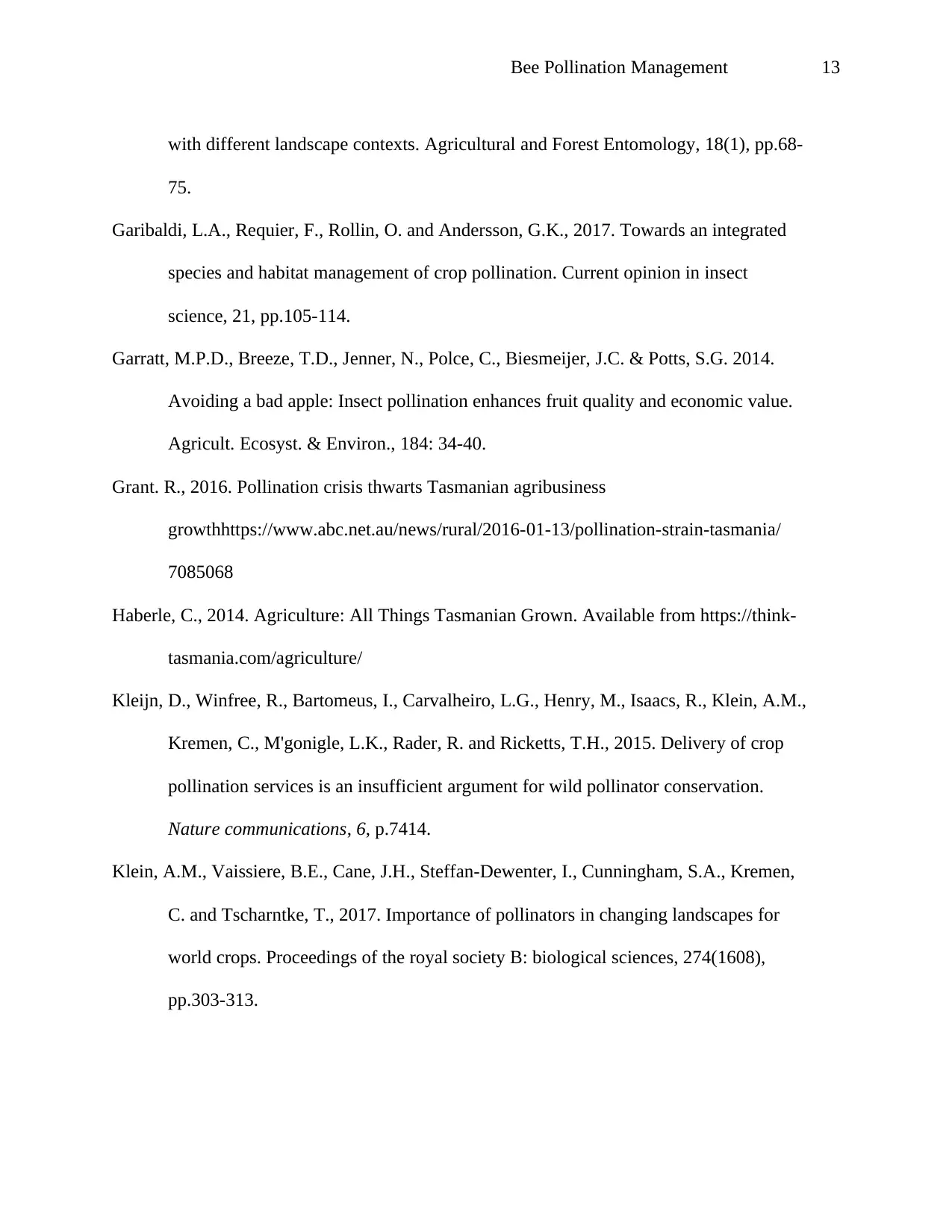
Bee Pollination Management 13
with different landscape contexts. Agricultural and Forest Entomology, 18(1), pp.68-
75.
Garibaldi, L.A., Requier, F., Rollin, O. and Andersson, G.K., 2017. Towards an integrated
species and habitat management of crop pollination. Current opinion in insect
science, 21, pp.105-114.
Garratt, M.P.D., Breeze, T.D., Jenner, N., Polce, C., Biesmeijer, J.C. & Potts, S.G. 2014.
Avoiding a bad apple: Insect pollination enhances fruit quality and economic value.
Agricult. Ecosyst. & Environ., 184: 34-40.
Grant. R., 2016. Pollination crisis thwarts Tasmanian agribusiness
growthhttps://www.abc.net.au/news/rural/2016-01-13/pollination-strain-tasmania/
7085068
Haberle, C., 2014. Agriculture: All Things Tasmanian Grown. Available from https://think-
tasmania.com/agriculture/
Kleijn, D., Winfree, R., Bartomeus, I., Carvalheiro, L.G., Henry, M., Isaacs, R., Klein, A.M.,
Kremen, C., M'gonigle, L.K., Rader, R. and Ricketts, T.H., 2015. Delivery of crop
pollination services is an insufficient argument for wild pollinator conservation.
Nature communications, 6, p.7414.
Klein, A.M., Vaissiere, B.E., Cane, J.H., Steffan-Dewenter, I., Cunningham, S.A., Kremen,
C. and Tscharntke, T., 2017. Importance of pollinators in changing landscapes for
world crops. Proceedings of the royal society B: biological sciences, 274(1608),
pp.303-313.
with different landscape contexts. Agricultural and Forest Entomology, 18(1), pp.68-
75.
Garibaldi, L.A., Requier, F., Rollin, O. and Andersson, G.K., 2017. Towards an integrated
species and habitat management of crop pollination. Current opinion in insect
science, 21, pp.105-114.
Garratt, M.P.D., Breeze, T.D., Jenner, N., Polce, C., Biesmeijer, J.C. & Potts, S.G. 2014.
Avoiding a bad apple: Insect pollination enhances fruit quality and economic value.
Agricult. Ecosyst. & Environ., 184: 34-40.
Grant. R., 2016. Pollination crisis thwarts Tasmanian agribusiness
growthhttps://www.abc.net.au/news/rural/2016-01-13/pollination-strain-tasmania/
7085068
Haberle, C., 2014. Agriculture: All Things Tasmanian Grown. Available from https://think-
tasmania.com/agriculture/
Kleijn, D., Winfree, R., Bartomeus, I., Carvalheiro, L.G., Henry, M., Isaacs, R., Klein, A.M.,
Kremen, C., M'gonigle, L.K., Rader, R. and Ricketts, T.H., 2015. Delivery of crop
pollination services is an insufficient argument for wild pollinator conservation.
Nature communications, 6, p.7414.
Klein, A.M., Vaissiere, B.E., Cane, J.H., Steffan-Dewenter, I., Cunningham, S.A., Kremen,
C. and Tscharntke, T., 2017. Importance of pollinators in changing landscapes for
world crops. Proceedings of the royal society B: biological sciences, 274(1608),
pp.303-313.
Paraphrase This Document
Need a fresh take? Get an instant paraphrase of this document with our AI Paraphraser

Bee Pollination Management 14
Locke, B., Forsgren, E. and de Miranda, J.R., 2014. Increased tolerance and resistance to
virus infections: a possible factor in the survival of Varroa destructor-resistant honey
bees (Apis mellifera). PloS one, 9(6), p.e99998.
Mallinger, R.E. & Gratton, C., 2015. Species richness of wild bees, but not the use of
managed honeybees, increases fruit set of a pollinator‐dependent crop. J. Appl. Ecol.,
52(2): 323-330.
Mader, E., Shepherd, M., Vaughan, M., Black, S. H., & LeBuhn, G. (2012). Attracting native
pollinators: protecting North America's bees and butterflies: Storey Pub
Mather. A., 2017. Bee industry: Call to open Tasmania for buzz. Available from
https://www.weeklytimesnow.com.au/news/tasmanian-country/bee-industry-call-to-
open-tasmania-for-buzz/news-story/d9d6905c3b21c58b94a7d4ee7e651087
Meixner, M.D., Kryger, P. and Costa, C., 2015. Effects of genotype, environment, and their
interactions on honey bee health in Europe. Current Opinion in Insect Science, 10,
pp.177-184.
Partap, U., 2014. Honey bees in mountain agriculture. Leisa India. March 2012. Pp. 5-12.
Russo, L., Park, M., Gibbs, J. & Danforth, B. 2015. The challenge of accurately documenting
bee species richness in agroecosystems: bee diversity in eastern apple orchards. Ecol.
Evol., 5(17): 3531-3540.
Sanchez-Bayo, F. and Goka, K., 2014. Pesticide residues and bees–a risk assessment. PloS
one, 9(4), p.e94482.
Sheffield, C.S. 2014. Pollination, seed set and fruit quality in apple: studies with Osmia
lignaria(Hymenoptera: Megachilidae) in the Annapolis Valley, Nova Scotia,
Canada. J. Pollination Ecol., 12(13): 120-128.
Locke, B., Forsgren, E. and de Miranda, J.R., 2014. Increased tolerance and resistance to
virus infections: a possible factor in the survival of Varroa destructor-resistant honey
bees (Apis mellifera). PloS one, 9(6), p.e99998.
Mallinger, R.E. & Gratton, C., 2015. Species richness of wild bees, but not the use of
managed honeybees, increases fruit set of a pollinator‐dependent crop. J. Appl. Ecol.,
52(2): 323-330.
Mader, E., Shepherd, M., Vaughan, M., Black, S. H., & LeBuhn, G. (2012). Attracting native
pollinators: protecting North America's bees and butterflies: Storey Pub
Mather. A., 2017. Bee industry: Call to open Tasmania for buzz. Available from
https://www.weeklytimesnow.com.au/news/tasmanian-country/bee-industry-call-to-
open-tasmania-for-buzz/news-story/d9d6905c3b21c58b94a7d4ee7e651087
Meixner, M.D., Kryger, P. and Costa, C., 2015. Effects of genotype, environment, and their
interactions on honey bee health in Europe. Current Opinion in Insect Science, 10,
pp.177-184.
Partap, U., 2014. Honey bees in mountain agriculture. Leisa India. March 2012. Pp. 5-12.
Russo, L., Park, M., Gibbs, J. & Danforth, B. 2015. The challenge of accurately documenting
bee species richness in agroecosystems: bee diversity in eastern apple orchards. Ecol.
Evol., 5(17): 3531-3540.
Sanchez-Bayo, F. and Goka, K., 2014. Pesticide residues and bees–a risk assessment. PloS
one, 9(4), p.e94482.
Sheffield, C.S. 2014. Pollination, seed set and fruit quality in apple: studies with Osmia
lignaria(Hymenoptera: Megachilidae) in the Annapolis Valley, Nova Scotia,
Canada. J. Pollination Ecol., 12(13): 120-128.
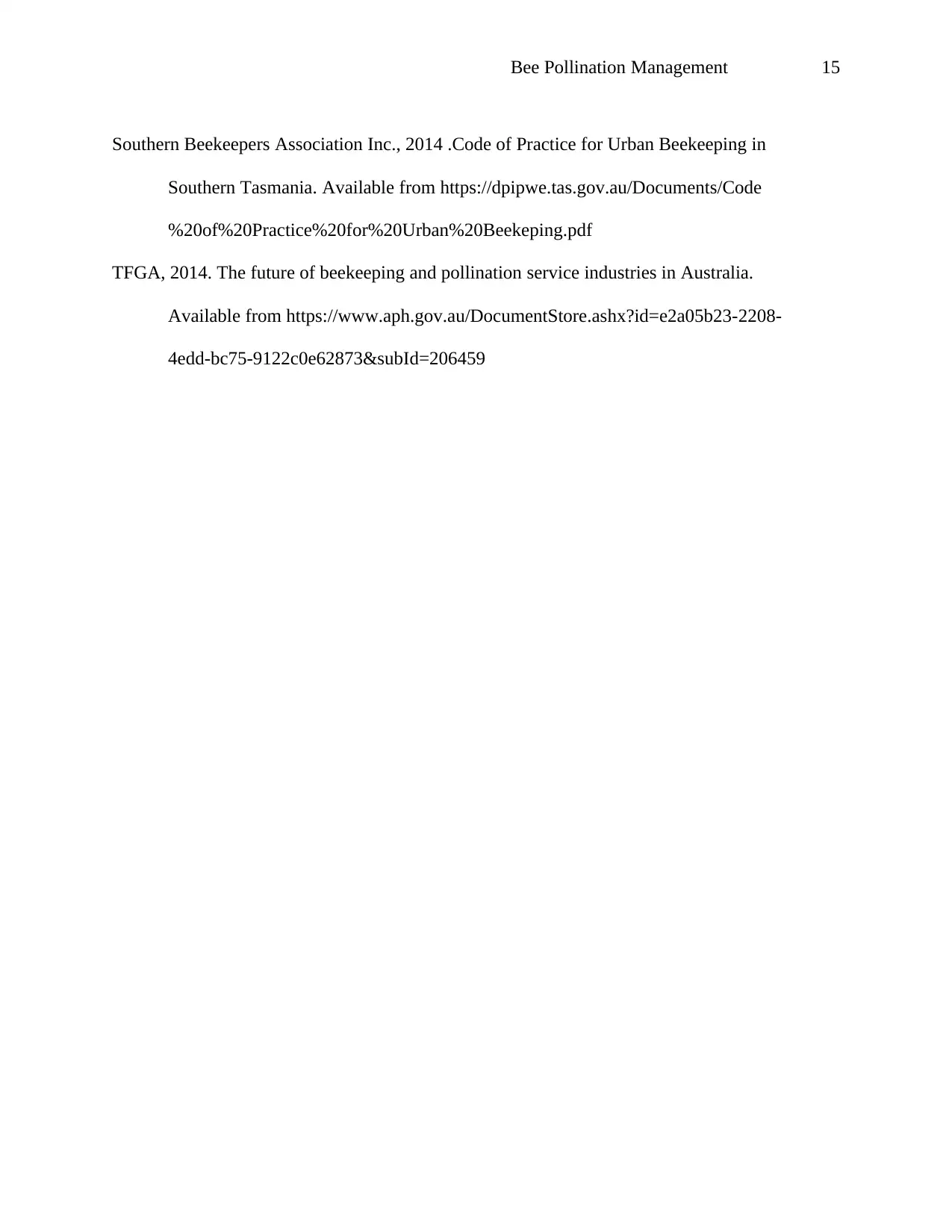
Bee Pollination Management 15
Southern Beekeepers Association Inc., 2014 .Code of Practice for Urban Beekeeping in
Southern Tasmania. Available from https://dpipwe.tas.gov.au/Documents/Code
%20of%20Practice%20for%20Urban%20Beekeping.pdf
TFGA, 2014. The future of beekeeping and pollination service industries in Australia.
Available from https://www.aph.gov.au/DocumentStore.ashx?id=e2a05b23-2208-
4edd-bc75-9122c0e62873&subId=206459
Southern Beekeepers Association Inc., 2014 .Code of Practice for Urban Beekeeping in
Southern Tasmania. Available from https://dpipwe.tas.gov.au/Documents/Code
%20of%20Practice%20for%20Urban%20Beekeping.pdf
TFGA, 2014. The future of beekeeping and pollination service industries in Australia.
Available from https://www.aph.gov.au/DocumentStore.ashx?id=e2a05b23-2208-
4edd-bc75-9122c0e62873&subId=206459
1 out of 15
Your All-in-One AI-Powered Toolkit for Academic Success.
+13062052269
info@desklib.com
Available 24*7 on WhatsApp / Email
![[object Object]](/_next/static/media/star-bottom.7253800d.svg)
Unlock your academic potential
© 2024 | Zucol Services PVT LTD | All rights reserved.